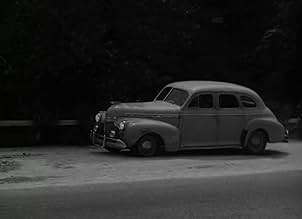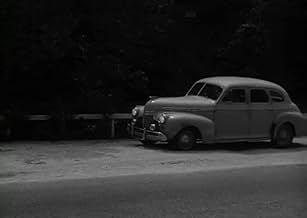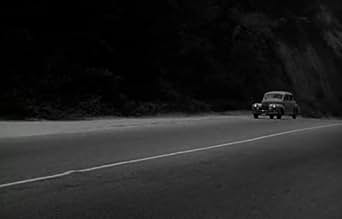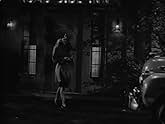IMDb RATING
6.7/10
2.4K
YOUR RATING
A mortally-wounded female gangster recounts how she and her gang revived an executed killer from the gas chamber to try to find out where he buried a fortune in cash.A mortally-wounded female gangster recounts how she and her gang revived an executed killer from the gas chamber to try to find out where he buried a fortune in cash.A mortally-wounded female gangster recounts how she and her gang revived an executed killer from the gas chamber to try to find out where he buried a fortune in cash.
Jean Gillie
- Margot Shelby
- (as Miss Jean Gillie)
Philip Van Zandt
- Tommy
- (as Phil Van Zandt)
Walden Boyle
- Chaplain
- (uncredited)
Martin Cichy
- Policeman
- (uncredited)
Tom Coleman
- Trucker at Roadside Inn
- (uncredited)
Franco Corsaro
- Kelsey
- (uncredited)
Madge Crane
- First Visitor
- (uncredited)
Dick Elliott
- Driver
- (uncredited)
Virginia Farmer
- Georgia - Margot's Maid
- (uncredited)
- Director
- Writers
- All cast & crew
- Production, box office & more at IMDbPro
Featured reviews
(April, 2000): Just saw a rare print at the American Cinematheque Noir festival and the film knocked my socks off. As evidenced by this performance, Jean Gillie would have been one of the greats of Noir had she not died in 1949. She powers through this film, getting man after man to do her bidding, never taking no for an answer. And the obstacles that would stop a lesser character don't bother her in the least. The problem confronting her: her boyfriend is on death row. Only he knows where $400,000 from a robbery is. And she uses her feminine wiles to persuade him, and two other men, to discern the location of that dough because, *she wants that money.* Even the gas chamber doesn't slow her down ... which is where the slight sci-fi element is introduced. If this turns up on late-night video, set your VCR. You will be amazed.
What a great B movie. In the powerful opening minutes, a wounded man hitchhikes to a San Francisco hotel, where he shoots an unarmed woman (Jean Gillie) and dies. While she lay dying, the woman tells a police detective (Sheldon Leonard) the events that led up to this. Her killer was a doctor she had duped into helping her bring her executed convict boyfriend back to life (!) so she could find out where he had stashed some loot. All through her story, it becomes clear this woman is pretty heartless and sadistic.
Jean Gillie was married to this film's director. This was his attempt to make her a star. Unfortunately nobody really became a star making pictures for Monogram, no matter how good they may have been. A short time later the pair divorced and Gillie moved back to England. She died there of pneumonia at the age of 33, just 3 years after this was released. Gillie showed how much potential she had in this movie. It's a shame her life was cut so short. Nice to see Sheldon Leonard playing a detective. He was usually playing tough gangsters. He's plenty tough here, even if he is on the right side of the law. Edward Norris and Herbert Rudley are both good. Robert Armstrong, the biggest name in the picture at the time, has little screen time as the executed boyfriend but does well with what he has.
Exceptional film noir from Monogram, a Poverty Row studio not known for much that was exceptional. There are a lot of memorable moments in this one. The beginning and ending are really great. The atmospheric scene where Armstrong is brought back to life is another highlight. With a couple of changes this could have easily been turned into a horror movie like The Man They Could Not Hang. It's definitely one you'll want to check out.
Jean Gillie was married to this film's director. This was his attempt to make her a star. Unfortunately nobody really became a star making pictures for Monogram, no matter how good they may have been. A short time later the pair divorced and Gillie moved back to England. She died there of pneumonia at the age of 33, just 3 years after this was released. Gillie showed how much potential she had in this movie. It's a shame her life was cut so short. Nice to see Sheldon Leonard playing a detective. He was usually playing tough gangsters. He's plenty tough here, even if he is on the right side of the law. Edward Norris and Herbert Rudley are both good. Robert Armstrong, the biggest name in the picture at the time, has little screen time as the executed boyfriend but does well with what he has.
Exceptional film noir from Monogram, a Poverty Row studio not known for much that was exceptional. There are a lot of memorable moments in this one. The beginning and ending are really great. The atmospheric scene where Armstrong is brought back to life is another highlight. With a couple of changes this could have easily been turned into a horror movie like The Man They Could Not Hang. It's definitely one you'll want to check out.
I have to say that Decoy was one interesting cinematic experience. The story had a lot of holes in it and the plan that was made by the bad guys had a lot of faults in it.
But what makes this film get as high a rating from me as I give it is the presence of Jean Gillie who made only one more film after this one before dying at 33. Just like another British beauty Kay Kendall.
Gillie is one devil woman and she's got one devilish plan to $400,000.00 of stolen loot that Robert Armstrong has hidden away. She's been Armstrong's moll for years, but he's going to the gas chamber. Never mind Gillie's found a way to beat the gas chamber. But it involves getting a doctor and another hoodlum to pull it off.
The key is Dr. Herbert Rudley who supervises the executions. There's a chemical if administered within a short time that can counteract the effects of cyanide. Gillie puts on quite a campaign to vamp Rudley and soon he's just putty. Her other hoodlum boyfriend Edward Norris is amused at Rudley, but he's also thinking with his crotch.
Even Sheldon Leonard playing a cop instead of gangster for once is also not immune to Gillie when she turns it on. If some company could have bottled what Gillie had and sold it to the government it would be quite a formidable weapon.
The script isn't all that great, but Gillie and the cast of sex struck males really put this Monagram classic over.
But what makes this film get as high a rating from me as I give it is the presence of Jean Gillie who made only one more film after this one before dying at 33. Just like another British beauty Kay Kendall.
Gillie is one devil woman and she's got one devilish plan to $400,000.00 of stolen loot that Robert Armstrong has hidden away. She's been Armstrong's moll for years, but he's going to the gas chamber. Never mind Gillie's found a way to beat the gas chamber. But it involves getting a doctor and another hoodlum to pull it off.
The key is Dr. Herbert Rudley who supervises the executions. There's a chemical if administered within a short time that can counteract the effects of cyanide. Gillie puts on quite a campaign to vamp Rudley and soon he's just putty. Her other hoodlum boyfriend Edward Norris is amused at Rudley, but he's also thinking with his crotch.
Even Sheldon Leonard playing a cop instead of gangster for once is also not immune to Gillie when she turns it on. If some company could have bottled what Gillie had and sold it to the government it would be quite a formidable weapon.
The script isn't all that great, but Gillie and the cast of sex struck males really put this Monagram classic over.
When Jean-Luc Godard dedicated Breathless to Monogram Pictures, foremost in his memory must have been Decoy. It's a movie whose reputation, over the years, has grown into folklore, because it's all but impossible to view or obtain. For aficionados of film noir, it has attained the stature of a Holy Grail (or Maltese Falcon), a fabulous treasure the quest for which seems doomed to futility. It has, however, showed up at festival screenings, and now circulating, in samizdat as it were, is a subtitled copy taped from Croatian television.
While probably it can't ever live up to the inflated legend that trails in its wake, it's decidedly no disappointment. Monogram and its raffish rivals on Poverty Row shot fast and cut corners, working from fast-and-loose scripts full of implausible chunks of plot for viewers either to swallow or choke on. Usually, the results were shoddy and forgettable. But now and again enough elements came together to generate unexpected chemistry. Decoy marks one such serendipitous occasion.
The key element in this explosive reaction is Jean Gillie, an English actress whose early death in 1949 deprived cinema of one of its darkest Jezebels. Like her compatriot Peggy Cummins (Annie Laurie Starr in Gun Crazy), she makes no attempt, as Margot Shelby, to Americanize her origins; in explanation, Decoy lets her spit out her contempt for poverty in an eloquent aria about that 'dingy, dirty street' that 'runs all over the world,' and through the sooty mill town in England she came from. She vows never to go back to want, and her unquenchable greed powers the plot.
Tricked out in haut-forties snoods, stoles, muffs and dead-serious hats, Gillie cuts a swath through the various men who stand between her and the $400-grand stolen by her gangster boyfriend (Robert Armstrong. Trouble is, he's the only one who knows where it's stashed but won't tell even though he's on death row.
But her days as a high-maintenance moll have taught her a thing or two, one of them that a tincture called Methylene Blue can reverse an execution by cyanide. She works her wiles on maverick mobster Edward Norris and an idealistic doctor who does prison autopsies (Herbert Rudley), enlisting them in her gruesome scheme. They hijack the fresh corpse, en route to an 'oven job,' and, in a sequence reminiscent of Frankenstein, bring it back to life.
Still, the tight-fisted old zombie won't trust them, instead roughing out a map to the buried strongbox but keeping half (why just half?) against the prospect of this second coming's failing to take. It's a turn of events that kicks Gillie's avarice into lethal overdrive....
Though the movie wouldn't be remarkable without Gillie, it shows a fair amount of craft. From his 11 recorded directorial credits, Jack Bernhardt couldn't have been expected to contribute much, but he adds some arresting details (a sprung window shade in the doctor's office among them) and an offbeat pace. He splits the ending in two, leaving half in its proper place and opening the movie with the other, in a gas-station men's room where the shattered mirror and filthy sink outdo one another as emblems of last-ditch squalor. Police detective Sheldon Leonard figures prominently in those two segments; the rest of the movie is told in extended flashback.
There's barely a moment when Gillie isn't front and center, for which gratitude should be fulsome. She delivers a go-for-broke performance, short on nuance but long on the flamboyant gesture. She coldly guns the motor to run down one of her victims, skitters into hysterical giggles when she shoots the next, and, dying, laughs in Leonard's face after coaxing him to kiss her ('Jo Jo, just this once, come down to my level'). She's a knockout, and because of her the elusive Decoy, despite the inevitable shortcomings of its Monogram origins, can be counted a knockout, too film noir with no frills.
While probably it can't ever live up to the inflated legend that trails in its wake, it's decidedly no disappointment. Monogram and its raffish rivals on Poverty Row shot fast and cut corners, working from fast-and-loose scripts full of implausible chunks of plot for viewers either to swallow or choke on. Usually, the results were shoddy and forgettable. But now and again enough elements came together to generate unexpected chemistry. Decoy marks one such serendipitous occasion.
The key element in this explosive reaction is Jean Gillie, an English actress whose early death in 1949 deprived cinema of one of its darkest Jezebels. Like her compatriot Peggy Cummins (Annie Laurie Starr in Gun Crazy), she makes no attempt, as Margot Shelby, to Americanize her origins; in explanation, Decoy lets her spit out her contempt for poverty in an eloquent aria about that 'dingy, dirty street' that 'runs all over the world,' and through the sooty mill town in England she came from. She vows never to go back to want, and her unquenchable greed powers the plot.
Tricked out in haut-forties snoods, stoles, muffs and dead-serious hats, Gillie cuts a swath through the various men who stand between her and the $400-grand stolen by her gangster boyfriend (Robert Armstrong. Trouble is, he's the only one who knows where it's stashed but won't tell even though he's on death row.
But her days as a high-maintenance moll have taught her a thing or two, one of them that a tincture called Methylene Blue can reverse an execution by cyanide. She works her wiles on maverick mobster Edward Norris and an idealistic doctor who does prison autopsies (Herbert Rudley), enlisting them in her gruesome scheme. They hijack the fresh corpse, en route to an 'oven job,' and, in a sequence reminiscent of Frankenstein, bring it back to life.
Still, the tight-fisted old zombie won't trust them, instead roughing out a map to the buried strongbox but keeping half (why just half?) against the prospect of this second coming's failing to take. It's a turn of events that kicks Gillie's avarice into lethal overdrive....
Though the movie wouldn't be remarkable without Gillie, it shows a fair amount of craft. From his 11 recorded directorial credits, Jack Bernhardt couldn't have been expected to contribute much, but he adds some arresting details (a sprung window shade in the doctor's office among them) and an offbeat pace. He splits the ending in two, leaving half in its proper place and opening the movie with the other, in a gas-station men's room where the shattered mirror and filthy sink outdo one another as emblems of last-ditch squalor. Police detective Sheldon Leonard figures prominently in those two segments; the rest of the movie is told in extended flashback.
There's barely a moment when Gillie isn't front and center, for which gratitude should be fulsome. She delivers a go-for-broke performance, short on nuance but long on the flamboyant gesture. She coldly guns the motor to run down one of her victims, skitters into hysterical giggles when she shoots the next, and, dying, laughs in Leonard's face after coaxing him to kiss her ('Jo Jo, just this once, come down to my level'). She's a knockout, and because of her the elusive Decoy, despite the inevitable shortcomings of its Monogram origins, can be counted a knockout, too film noir with no frills.
Jean Gillie (Margot) devises a plan to spring her lover Robert Armstrong (Frank) from prison. She gets help for her plan from Edward Norris (Jim) and an unwilling Herbert Rudley (Dr Craig)). The idea is to get Armstrong to locate some hidden money for them to share. However, there are ulterior motives at play......
Methylene blue is at the centre of this story. It is used in the plot to revive Robert Armstrong after he has been killed as it is an antidote to cyanide poisoning. However, be careful if you want to experiment on someone you don't like very much as it serves as an antidote to the poison while you are living and not after you have died. It takes nothing away from the good idea for the plot though. However, poor Robert Armstrong doesn't live for very long after he is revived and so we don't get to see the side-effects of this drug, which turns your urine green and makes the whites of your eyes blue - we would then have been in a completely different film genre, possibly a comedy horror.
The cast do well despite 3 of them not being very good at acting - Jean Gillies, Herbert Rudley and, in a minor part, Marjorie Woodworth. Jean Gillies, while she is the driving force behind the film is either very good as demonstrated by her ruthlessness while at the steering wheel on the way to dig up the money and her determined self-confidence as she knows what she needs to do, or dreadfully unconvincing as in her scene when she talks about coming from the dirty street to which she never wants to return (her posh Kensington accent fools nobody - she's NEVER been a girl from the streets) and her insane encouragement to Herbert Rudley to dig for the money. Her OTT hysterics are not convincing in both these examples. It is funny to watch, though. Herbert Rudley plays a broken man for most of the film and comes across as a wet fish which is frustrating, although he comes good right at the beginning when he finally becomes a man and pulls a trigger. Still, he is annoying to watch for most of the time as this story unfolds in flashback. As for Marjorie Woodworth who plays Rudley's nurse and girlfriend.....ha ha ha....she's just terrible.
The film is well-paced and atmospheric, eg, the scene when Herbert Rudley is reviving Robert Armstrong and the scene where Jean Gillies engineers a flat tyre situation as she, Rudley and Norris make it to the location where the loot is buried. It is a shame that the film has been cut as it would have been far more powerful and disturbing to see Gillies do what she does to Norris twice as originally filmed as opposed to the one time she does it (which is shocking enough). And her laughter as she fools Sheldon Leonard who plays Sergeant Joe Portugal provides a memorable ending. She was one mean bitch.
The acting is sometimes wooden, the dialogue is sometimes woeful (a very annoying comedy duo at the morgue provide an example of this along with the claptrap speech about coming from that dirty street that Gillies delivers), a posh English accent seems a wrong choice for the lead role and the music is sometimes way too over dramatic but somehow, it doesn't seem to matter. What would normally be a recipe for disaster strangely has a very different effect and produces an entertaining film.
It is sad to discover that in real life, Jean Gillies died of pneumonia 3 years later in 1949 in London.
Methylene blue is at the centre of this story. It is used in the plot to revive Robert Armstrong after he has been killed as it is an antidote to cyanide poisoning. However, be careful if you want to experiment on someone you don't like very much as it serves as an antidote to the poison while you are living and not after you have died. It takes nothing away from the good idea for the plot though. However, poor Robert Armstrong doesn't live for very long after he is revived and so we don't get to see the side-effects of this drug, which turns your urine green and makes the whites of your eyes blue - we would then have been in a completely different film genre, possibly a comedy horror.
The cast do well despite 3 of them not being very good at acting - Jean Gillies, Herbert Rudley and, in a minor part, Marjorie Woodworth. Jean Gillies, while she is the driving force behind the film is either very good as demonstrated by her ruthlessness while at the steering wheel on the way to dig up the money and her determined self-confidence as she knows what she needs to do, or dreadfully unconvincing as in her scene when she talks about coming from the dirty street to which she never wants to return (her posh Kensington accent fools nobody - she's NEVER been a girl from the streets) and her insane encouragement to Herbert Rudley to dig for the money. Her OTT hysterics are not convincing in both these examples. It is funny to watch, though. Herbert Rudley plays a broken man for most of the film and comes across as a wet fish which is frustrating, although he comes good right at the beginning when he finally becomes a man and pulls a trigger. Still, he is annoying to watch for most of the time as this story unfolds in flashback. As for Marjorie Woodworth who plays Rudley's nurse and girlfriend.....ha ha ha....she's just terrible.
The film is well-paced and atmospheric, eg, the scene when Herbert Rudley is reviving Robert Armstrong and the scene where Jean Gillies engineers a flat tyre situation as she, Rudley and Norris make it to the location where the loot is buried. It is a shame that the film has been cut as it would have been far more powerful and disturbing to see Gillies do what she does to Norris twice as originally filmed as opposed to the one time she does it (which is shocking enough). And her laughter as she fools Sheldon Leonard who plays Sergeant Joe Portugal provides a memorable ending. She was one mean bitch.
The acting is sometimes wooden, the dialogue is sometimes woeful (a very annoying comedy duo at the morgue provide an example of this along with the claptrap speech about coming from that dirty street that Gillies delivers), a posh English accent seems a wrong choice for the lead role and the music is sometimes way too over dramatic but somehow, it doesn't seem to matter. What would normally be a recipe for disaster strangely has a very different effect and produces an entertaining film.
It is sad to discover that in real life, Jean Gillies died of pneumonia 3 years later in 1949 in London.
Did you know
- TriviaMethylene blue is a real chemical compound, discovered in 1896 (by Heinrich Caro), which does indeed have the ability to counteract cyanide poisoning. This property was discovered in 1933 by Dr. Matilda Moldenhauer Brooks of San Francisco. It will not, however, restore life to those who have died from cyanide poisoning.
- GoofsWhen Joe walks into the bar, he pauses by the piano. The piano player raises his left hand off the keyboard to wave to Joe, but the piano music continues as if both his hands are still playing.
- Quotes
Sergeant Joe Portugal: Don't let that face of yours go to your head.
Margot Shelby: Or to yours?
Sergeant Joe Portugal: It wouldn't matter if did... People who use pretty faces like you use yours, don't live very long anyway.
- ConnectionsFeatured in Film Noir: Bringing Darkness to Light (2006)
- How long is Decoy?Powered by Alexa
Details
- Runtime1 hour 16 minutes
- Color
- Aspect ratio
- 1.33 : 1
Contribute to this page
Suggest an edit or add missing content
































